COMMENTS ON THE ART MARKET
Gallery Exhibitions – A Trifecta
Opening Night – October 5th at 4:30 pm

The Seasons: Exploring Nature's Palette.
This captivating exhibition celebrates the beauty of the natural world through the eyes of some of today's most talented landscape artists. The exhibit will showcase remarkable works by more than a dozen artists, including Andrew Orr, Ben Bauer, Gail Descoeurs, Kathleen Dunphy, Ken Salaz, Ryan Brown, D. Eleinne Basa, Leo Mancini-Hresko, Todd Casey, and many more. Visitors can anticipate a visual journey through the changing seasons, as these artists skillfully capture the ever-evolving colors, moods, and landscapes of nature.
____________________

City Life: The Hustle and Bustle
Also opening on October 5th, at 4:30 pm, is our exhibition City Life: The Hustle and Bustle. The exhibition features 16 extraordinary pieces by artists like Lucien Adrion, Johann Berthelsen, Antoine Blanchard, Edouard Leon Cortes, Constantin Kluge, and Martin Rico y Ortega. Each painting tells a unique story of city life, inviting viewers to step into the scenes and experience the magic of these bygone eras.
____________________

Mitsuru Watanabe
We are thrilled to announce an upcoming art exhibition that promises to be a captivating journey into the world of Japanese artist Mitsuru Watanabe. This intimate solo show will shine a spotlight on six of his remarkable works, with four of them making their debut at our gallery. Step into the surreal and imaginative realm of Watanabe as he unveils pieces like Babel and Pudding, Rousseau's Music of the Night, Naoko Bathing in the Orange Forest of Rousseau, and Naoko Playing in Bosch's Hell. Each piece is a testament to his unique artistic vision and the fusion of diverse influences that make his work a mesmerizing experience. Join us in celebrating the creativity of Mitsuru Watanabe and his contribution to the contemporary art world.
All three shows will run concurrently.
Opening Night
Thursday, October 5: 4:30 pm – 7:30 pm
General Show Days
Monday – Friday
October 9 – October 31
10:00 am – 5:00 pm
____________________
Stocks & Crypto
Welp, September is in the books and it wasn’t good… not that that’s unusual. I’m sure some of you know, but historically speaking, September is the worst month for stocks on average – and that’s going back more than a century! I haven’t found a solid explanation as to why that is, but one expert seems to think it’s because traders aren’t paying much attention in the summer months while they’re off traveling and playing rounds of golf… then, as the summer winds down, everyone gets back to work and starts processing all the lingering bad news from the last few months. Hey, it’s what the expert said, not me… what do I know? I just sell paintings, not financial advice.
Keeping with the trend, September ranked as the worst month for all three major indexes… the Dow declined 3.5% for the month, and 2.6% for Q3; the tech-heavy Nasdaq slid 5.8% this month, and 4.1% for the quarter; and the S&P500 was down 4.9% for September, and 3.7% for the quarter. For months there has been rising hope that the Fed was orchestrating a so-called “soft landing,” but as interest rates linger at high levels, the long-term outlook gets murkier. On top of that, the dysfunction in our congress is bordering on pathetic as we are on the brink of a government shutdown – that’s certainly not helping anything.
When it comes to currencies and commodities… both the British Pound and Euro weakened relative to the dollar; the Pound down about 4%, while the Euro was closer to 3.25%. In the final days of September, Gold futures shed quite a bit of value… Gold prices tumbled to a 6 month low and recorded a decline of roughly 4% for September. Crude was the outlier, as it steadily climbed through the month – it finished off with a gain of nearly 12%!
In the crypto world, the numbers are pretty underwhelming compared to what we’re used to seeing… Bitcoin sits just shy of $27K, which was good for a 3.8% gain through September. Ethereum notched a gain of just 1.5%, while Litecoin was up 2.5%... sure there was some volatility, but not as bad as we’ve seen in past months.
It wasn’t too long ago that the markets seemed to be worry free… that certainly seems to be changing, but then again, it could just be another typical September slide.
____________________
Really!?
Bouquinistes: Guardians Of The Literary Treasures Of Paris
 Well, folks, hold onto your berets because there's a real showdown happening in the City of Light. The bouquinistes of Paris, those green-clad guardians of literary treasures, have found themselves in quite the pickle thanks to the 2024 Olympics.
Well, folks, hold onto your berets because there's a real showdown happening in the City of Light. The bouquinistes of Paris, those green-clad guardians of literary treasures, have found themselves in quite the pickle thanks to the 2024 Olympics.
The Olympic planners have promised us a spectacle like nothing you've really seen before. Picture this: the Parade of Nations, not in a stuffy indoor venue, but on the Seine River with about 160 boats. It's like saying, "Who needs a stadium when you've got a river, right?" But, as you can imagine, turning the Seine into an Olympic stage comes with its own set of challenges, especially in the security department. So, here comes the city's proposal: let's temporarily relocate the bouquinistes stalls for the event.
Now, the bouquinistes are not your average booksellers. They are the guardians of the literary treasures of Paris, adding charm and intellectual pizzazz for centuries. They create an atmosphere that draws in bookworms, art lovers, and deep thinkers like moths to a literary flame.
But, oh boy, the controversy! The bouquinistes are upset about being left out of the decision-making process. Can you really blame them? These stalls are more than just places to buy books; they're symbols of Paris's artistic and intellectual spirit. If they vanish or get permanently shuffled around, it could change the whole vibe of the city, and that's not something to take lightly.
So, what's going to happen next? Well, it's a bit of a cliffhanger, my friends. The fate of the bouquinistes and their stalls is in the hands of the city's authorities. Can they find a solution that preserves both Paris's cultural heritage and its ability to host the Olympics in style? Parisians and visitors alike are going to be watching this drama unfold like it's the latest episode of a riveting TV series.
Now, wouldn't it be a real bummer if those bouquinistes stalls didn't return along the Seine River? Those stalls have been an essential part of the city's cultural tapestry, and their absence would leave a gap that's as noticeable as a missing Eiffel Tower. But take heart, my friends, because we've got exquisite paintings by artists like Édouard Cortès, Antoine Blanchard and Constantin Kluge to remind us of the bouquinistes' rich history.
These artworks capture the essence of Parisian life and architecture, often featuring scenes along the Seine that really resonate with the spirit the bouquinistes have infused into the city. So, while it would be a tad gloomy if their stalls didn't return, the legacy of the bouquinistes can live on through the timeless beauty of these artworks.
Freddie Mercury Rocked The Auction World

I wanted to briefly update you on the sale that ROCKED the auction world! The six-series auction of Freddie Mercury's personal items managed to defy all expectations by generating an astonishing £39.9 million ($50.4 million). This astronomical figure vastly surpassed the original estimate of £7.6 million to £11.3 million, leaving fans and auctioneers in awe.
Over the span of just one week, more than 30,000 items from Freddie Mercury's personal collection found new homes. The overwhelming success of this auction is a testament to the enduring fascination with Freddie Mercury and the indelible mark he left on the world of music and performance.
It's clear that Freddie Mercury's legacy continues to captivate hearts and wallets, proving that the legendary Queen frontman's influence knows no bounds and will continue to Rock On.
A Queen's Ransom
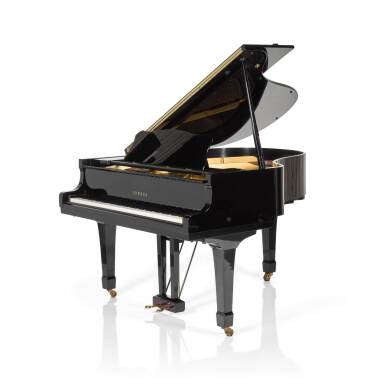 Freddy Mercury was a rock legend who sang his heart out in "Somebody to Love" as if he was composing a personal ad for love. However, he probably didn't realize that while searching for someone to love, countless somebodies were already swooning over him. And that, my friends, was proven beyond a shadow of a doubt at the first of several auctions this week celebrating Mercury's incredible life, work, and pure artistry. Most pieces sold for a Queen's Ransom.
Freddy Mercury was a rock legend who sang his heart out in "Somebody to Love" as if he was composing a personal ad for love. However, he probably didn't realize that while searching for someone to love, countless somebodies were already swooning over him. And that, my friends, was proven beyond a shadow of a doubt at the first of several auctions this week celebrating Mercury's incredible life, work, and pure artistry. Most pieces sold for a Queen's Ransom.
Mercury's stash of over 1,400 personal treasures, neatly tucked away in his London home for three decades, is finally up for grabs at Sotheby's. His ex-fiancé and confidant, Mary Austin, decided it was time to bid farewell to these gems.
The first of six auctions started on Wednesday with the crowd belting out "We Will Rock You," followed by a 20-minute brawl (well, not literal fisticuffs, but you get the idea) for the first item: the graffiti-covered door of Mercury's home. When the hammer finally came down, a phone bidder dropped half a million dollars on that doodled door! Remember, it was supposed to fetch a modest £15-25K, but it said, "Nah, I'm worth more!" and sold for £325K (£413K w/p - $521K).
The real rockstar of the show was Mercury's trusty Yamaha baby grand piano, which helped create Queen's greatest hits, including the timeless "Bohemian Rhapsody." It ended up bringing in a cool £1.4M (£1.74M w/p - $2.2M), just a tad short of the estimated £2-3M, but still, that's one heck of a piano.
Speaking of "Bohemian Rhapsody" (fun fact: it was once called "Mongolian Rhapsody"), Mercury's handwritten lyrics made a princely sum of £1.1M (£1.38M w/p- $1.8M) on an estimate of £800K-1.2M. "We Are the Champions" lyrics grabbed £250K (£317.5M w/p - $401K), and the autographed draft lyrics to "Somebody to Love" won someone's heart and emptied their pockets at £190K (£241K w/p - $305K).
And if that wasn't enough, Mercury's art collection turned heads too. A Picasso print snagged £150K (£190.5K w/p -$240k), which is way more than the estimate of £50-70K. A Joan Miró piece flew past its £15-20K estimate and sold for £70K (£89K w/p -$112K).
But wait, there's more! The man's iconic stage costumes were a hit as well. Mercury's crown and cloak ensemble ended up selling for £500K (£635K w/p -$801,500). His rainbow jacket from the "Hot Space" tour earned a dazzling £160K (£203K w/p -$256K), way over its estimated worth of £10-15K.
Now, here's the real shocker: a silver snake bangle from the "Bohemian Rhapsody" video went for nearly 100 times its estimated value of £7-9K, raking in a jaw-dropping £550K (£698.5K w/p - $882K). Sorry, John Lennon, you've been dethroned as the jewelry champ!
Lastly, a vintage Wurlitzer jukebox that still grooves like it's the '80s was estimated at £15-25K. It ended up fetching an astonishing £320K (£406.4K w/p -$513,000). It's got all of Mercury's favorite tunes, including classics by Ray Charles and Little Richard. So, in the end, Freddie's stuff rocked the auction world like only he could.
And to cap it all off, the final tally blew all expectations out of the water. Sotheby's specialists predicted the entire six-sale series to bring in a maximum of £7.2M ($9M). But the first night's sale alone hauled in a staggering £12.2M ($15.4M). So, I am sure when the grand finale takes place, we can confidently say that Freddy Mercury really hit some high notes, and the world is still singing along.
____________________
The Dark Side
Money For Nothing: Artist Ordered To Pay For Stunt
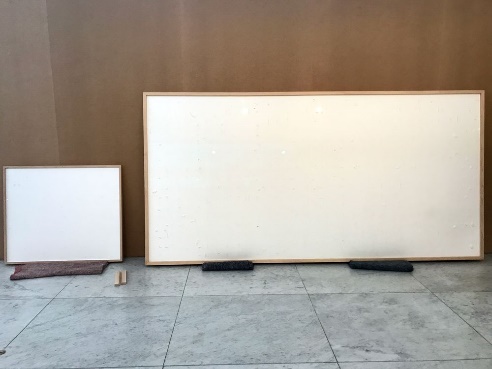 Nearly two years ago, the Danish conceptual artist Jens Haaning made headlines as the Kunsten Museum in Aalborg unveiled his newest works: two blank canvases. It was reported at the time that he originally promised to recreate one of his earlier works, for which the museum gave him 534,000 Danish kroner (or $84,000). However, they only got the blank canvases, which Haaning called Take the Money and Run. But now the museum is having the last laugh, as a court just ordered Haaning to pay everything back.
Nearly two years ago, the Danish conceptual artist Jens Haaning made headlines as the Kunsten Museum in Aalborg unveiled his newest works: two blank canvases. It was reported at the time that he originally promised to recreate one of his earlier works, for which the museum gave him 534,000 Danish kroner (or $84,000). However, they only got the blank canvases, which Haaning called Take the Money and Run. But now the museum is having the last laugh, as a court just ordered Haaning to pay everything back.
Originally, the Kunsten Museum asked Haaning to recreate one of his earlier works where he attached banknotes to two differently-sized canvases as a commentary on income disparity between Denmark and other European countries, in this case Austria. The larger canvas contained several hundred Danish krone banknotes, adding up to about 278,500 kroner (or about $49,568 in 2010). The smaller canvas, representing Austria, included Euro notes and a couple of coins, adding up to about €25,700 (or $35,209 in 2007 at the time of its creation). It was meant to be a commentary on how money is often an abstract indicator of a person’s or, in this case, a whole nation’s worth. That is until you lay it all out in physical form. The museum provided the kroner in cash for use in the installation. However, Haaning must have been listening to too much Steve Miller Band that day and decided to take some ill-suited advice. The museum received the two canvases, but they were completely blank, not a banknote in sight.
The museum administration tried to play it off, with the museum director Lasse Andersson referring to the stunt as “a humorous comment” critiquing the concept of being paid in exchange for a skill. Haaning defended himself on Danish radio, saying that Take the Money and Run is a piece of concept art and, therefore, not theft. If he returned the money, the work would no longer be art. “The work is that I have taken their money”. However, in the end, the museum demanded the money back. After Haaning refused, the museum sued him for breach of contract. This past Monday, September 18th, a court ordered Haaning to pay a little more than 492,000 kroner (or $70,496); the original amount with the artist's and viewing fees taken out, as the museum had exhibited the canvases despite the stunt. However, the artist was also ordered to pay 78,500 kroner (or $11,248) in court fees.
Nazi-Looted Schiele Works Seized
The Manhattan District Attorney’s office has been rather busy as of late. Several weeks ago, they confiscated an ancient Roman sculpture from the Cleveland Museum of Art believed to have been looted from an archaeological site in Turkey. And now, investigators have seized several works from out-of-state museums by the Austrian expressionist Egon Schiele that the Nazis stole from their original owner.
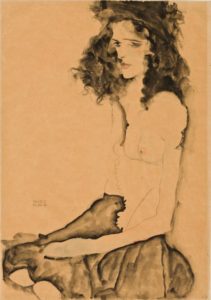
The three works were once in the collection of Fritz Grünbaum, an Austrian Jewish actor, singer, and songwriter who gained popularity performing in cabarets and theaters across Austria and Germany. Not long after Nazi Germany annexed Austria, Grünbaum attempted to flee to Czechoslovakia but was detained and sent to Dachau concentration camp. He was forced to sign over power of attorney, allowing the state to confiscate his art collection. He died at Dachau in 1941. Over the decades, the contents of his collection became dispersed throughout the world. In the last ten years or so, new research has uncovered the true provenance of some works. Furthermore, Grünbaum’s heirs have successfully made their case through the legal system. In 2019, the New York County Supreme Court ruled in their favor against the London art dealer Richard Nagy, stating that Grünbaum had signed over power of attorney under duress and was therefore invalid. This means that any work from his collection is still considered stolen, regardless of whether those possessing his works legally obtained them.
The Manhattan DA’s office confiscated works from three out-of-state cultural institutions: the Art Institute of Chicago, the Allen Memorial Art Museum at Oberlin College, Ohio, and the Carnegie Museums in Pittsburgh. The works confiscated were two watercolor and pencil works on paper entitled Russian War Prisoner (1916, valued at around $1.25 million) and Girl with Black Hair (1911, valued at $1.5 million), as well as a pencil drawing on paper called Portrait of a Man (1917, valued at around $1 million). The Carnegie Museums released a statement expressing that they are fully cooperating and are “acting in accordance with ethical, legal, and professional requirements and norms”. Oberlin College has not yet released a statement, but the Art Institute of Chicago certainly has. They seem less cooperative than the Carnegie Museums, coming across as a little resistant by claiming they are “confident in our legal acquisition and lawful possession of this work.”
The Manhattan DA’s confiscation adds complexity to currently ongoing civil cases. Grünbaum’s heirs are already suing these three institutions, as well as the Museum of Modern Art, the Morgan Library, and the Santa Barbara Museum of Art, to have around a dozen Schiele works returned. The fact that any district attorney’s office is getting involved means that what was once a civil matter may turn into a criminal case. It’s unlikely, but one never knows.
Stolen Van Gogh Found
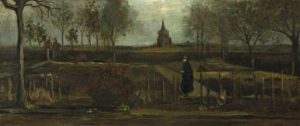 Two months after the World Health Organization declared COVID-19 a public health emergency of international concern, one of the most recent major art thefts of note took place. On March 30, 2020, a lone thief broke into the Springer Laren Museum outside of Amsterdam and stole Vincent van Gogh’s 1884 painting, The Parsonage Garden at Nuenen. Van Gogh created the work while staying with his parents in the southern Netherlands. It had been in the Groninger Museum collection since 1962 but had been on loan to the Springer Laren Museum when the robbery occurred. Appropriately, or perhaps inappropriately, the theft took place on the artist’s 167th birthday. However, after nearly three-and-a-half years, the painting has been located and recovered.
Two months after the World Health Organization declared COVID-19 a public health emergency of international concern, one of the most recent major art thefts of note took place. On March 30, 2020, a lone thief broke into the Springer Laren Museum outside of Amsterdam and stole Vincent van Gogh’s 1884 painting, The Parsonage Garden at Nuenen. Van Gogh created the work while staying with his parents in the southern Netherlands. It had been in the Groninger Museum collection since 1962 but had been on loan to the Springer Laren Museum when the robbery occurred. Appropriately, or perhaps inappropriately, the theft took place on the artist’s 167th birthday. However, after nearly three-and-a-half years, the painting has been located and recovered.
Arthur Brand, a Dutch art historian who has become a specialist in tracking down lost and stolen artworks, worked alongside Dutch police in locating the Van Gogh. The last photo of the painting surfaced a few months after the robbery. The perpetrators released a picture alongside a copy of that day’s New York Times international edition, like a cartoon villain would do in a hostage situation to show proof of life. In April 2021, over a year after the incident, Dutch authorities arrested a 58-year-old man on suspicion of stealing several paintings by Van Gogh and Frans Hals, amounting to over $22 million. They now believe that a cocaine smuggler in Dutch police custody had ordered the robbery to gain leverage against prosecutors to negotiate shortening his sentence. The Parsonage Garden at Nuenen was only slightly damaged, but is still in good condition.
Brand predicted that because of Van Gogh's fame as well as the robbery's coverage, the thieves would have very few options as to how to get rid of the painting. Stolen art can be a double-edged sword in that way. It’s valuable, the stolen Van Gogh itself being worth between €3 million and €6 million (or $3.2 million to $6.4 million). However, because art theft is often thoroughly documented, it becomes impossible to sell. That’s why museum and gallery thefts like the Gardner Museum heist have yet to be solved. On Monday night, Brand said someone reached out to him to hand over the Van Gogh. This person came to his Amsterdam apartment with a blue IKEA bag containing the stolen Van Gogh packed in bubble wrap. Brand compared the painting, both the front and back, to the images released in June 2020 and confirmed that they indeed possessed the stolen painting. Brand also invited Andreas Blühm, director of the Groninger Museum, to authenticate it himself.
The Parsonage Garden at Nuenen has since been turned over to the Van Gogh Museum in Amsterdam for restoration.
Picassos Or Pikachus: Fakes Seized In Spain
Art forgery is one of the most lucrative criminal enterprises in Spain. The Spanish government takes the country's national heritage and culture very seriously, so reports of police seizing forgeries are far more frequent. This past April, I wrote about how the Historic Heritage division of Valencia’s regional police seized five paintings by Spanish Old Masters, which turned out to be some of the worst and laziest fakes I’ve ever seen. There have been more seizures since that story broke in April, but the most recent one occurred in Valencia again. Police have seized five paintings from separate owners, all forgeries with fake documents.
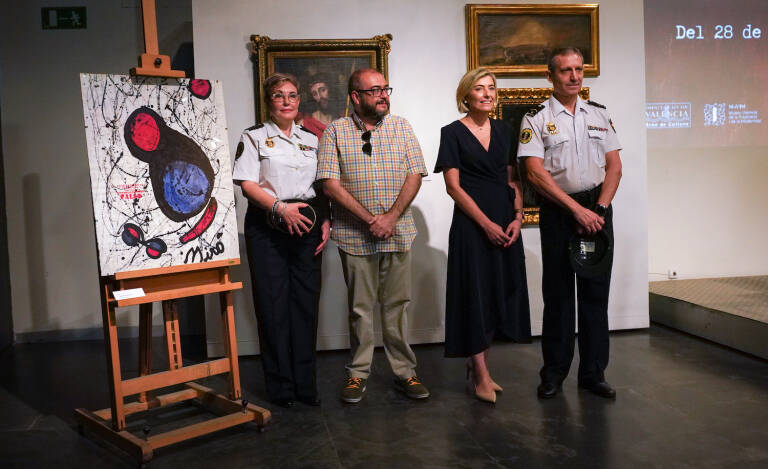 The five seized works consisted of two allegedly by Goya, one allegedly by Renoir, one allegedly by Joan Miró, and one allegedly by Vicente Juan Masip (also known as Juan de Juanes). These works had proper-looking but fake documents attesting to their authenticity and value. The owner of the Goya portrait stated they had purchased the painting in 1999 for around €230,000. The other Goya work, a battle scene from Spain's struggle against Napoleon's invasions, had valuation documents stating it would fetch between €1.5 million and €1.8 million at auction. Since 2014, Valencia‘s Historic Heritage unit has performed over 2,000 seizures, confiscating around 6,000 counterfeits and forgeries worth €376 million. They receive tips from cultural centers and perform random searches on art and antique dealers. However, the fakes themselves are somewhat sloppy. For instance, regarding the Renoir floral still-life, the head of the Historic Heritage division, Antonio López, remarked that “the pictorial quality is clearly inferior. Anyone who looks at other floral works by the painter could easily see that.” Furthermore, the Ecce Homo painting attributed to Masip, a copy of a genuine Masip painting kept at the Prado Museum, was executed on canvas mounted on board. Masip tended to paint directly on the panel.
The five seized works consisted of two allegedly by Goya, one allegedly by Renoir, one allegedly by Joan Miró, and one allegedly by Vicente Juan Masip (also known as Juan de Juanes). These works had proper-looking but fake documents attesting to their authenticity and value. The owner of the Goya portrait stated they had purchased the painting in 1999 for around €230,000. The other Goya work, a battle scene from Spain's struggle against Napoleon's invasions, had valuation documents stating it would fetch between €1.5 million and €1.8 million at auction. Since 2014, Valencia‘s Historic Heritage unit has performed over 2,000 seizures, confiscating around 6,000 counterfeits and forgeries worth €376 million. They receive tips from cultural centers and perform random searches on art and antique dealers. However, the fakes themselves are somewhat sloppy. For instance, regarding the Renoir floral still-life, the head of the Historic Heritage division, Antonio López, remarked that “the pictorial quality is clearly inferior. Anyone who looks at other floral works by the painter could easily see that.” Furthermore, the Ecce Homo painting attributed to Masip, a copy of a genuine Masip painting kept at the Prado Museum, was executed on canvas mounted on board. Masip tended to paint directly on the panel.
Police stated it’s likely that the original forgers took advantage of the false documents and the buyers’ lack of art knowledge to convince them to buy. “They were sold as Picassos, but they were actually Pikachus,” said López. These forgery rings are likely used to launder money or finance other criminal organizations.
British Museum Theft: The Root Cause?
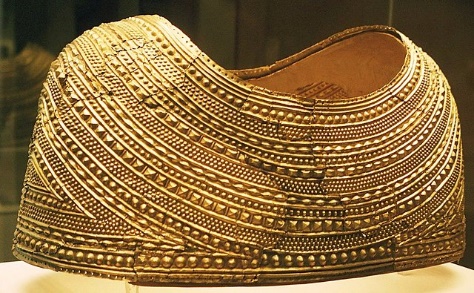 This is an update on the situation at the British Museum. Last month, it was revealed that Peter John Higgs, the museum's former curator of Greco-Roman art, was fired after he was found to have stolen and/or damaged 1,500 to 2,000 items from museum storerooms over several years. The museum only uncovered Higgs’s hobby after an antiquities dealer found some of the works he stole on eBay. It’s unlikely he was doing it for the money since items worth tens of thousands of pounds were found online for sale with a £40 reserve. Since then, museum director Hartwig Fischer has stepped down several months ahead of his intended departure at the end of the year. He has since been replaced by a new interim director, Sir Mark Jones, who previously headed the National Museums Scotland and London’s Victoria & Albert Museum. Jones previously worked at the British Museum, where, between 1974 and 1990, he served as assistant keeper of coins and medals.
This is an update on the situation at the British Museum. Last month, it was revealed that Peter John Higgs, the museum's former curator of Greco-Roman art, was fired after he was found to have stolen and/or damaged 1,500 to 2,000 items from museum storerooms over several years. The museum only uncovered Higgs’s hobby after an antiquities dealer found some of the works he stole on eBay. It’s unlikely he was doing it for the money since items worth tens of thousands of pounds were found online for sale with a £40 reserve. Since then, museum director Hartwig Fischer has stepped down several months ahead of his intended departure at the end of the year. He has since been replaced by a new interim director, Sir Mark Jones, who previously headed the National Museums Scotland and London’s Victoria & Albert Museum. Jones previously worked at the British Museum, where, between 1974 and 1990, he served as assistant keeper of coins and medals.
Since news of the Higgs theft broke, calls for repatriating stolen items kept at the British Museum have only intensified. Since the theft itself is a massive security breach, the incident has all but destroyed one of the last somewhat valid arguments in favor of keeping global cultural heritage in London, that being the British Museum's reputation as an incredibly well-funded, secure, and prestigious place to house such a massive multicultural collection. With the British Museum losing its reputation as a secure repository for art and artifacts, the arguments for repatriation seem stronger than ever. Of course, Greece and Nigeria are some of the more well-known countries asking for their cultural heritage back. Bronze artworks looted from Benin City by British soldiers and marble sculptures taken from the Parthenon are some of the most famous stolen works infamously and defiantly kept in the British Museum's collection. But with the news of the theft, several other countries are now asking for the return of their items. Chinese state media has called on the museum to return any items from its 23,000-piece Chinese collection acquired improperly or illegally. Ethiopia has renewed its efforts for the museum to return its Maqdala Collection, made up of Ethiopian artifacts looted by soldiers from Emperor Tewodros II’s palace during the British invasion of the country in 1868. There have even been repatriation requests from Wales, England’s next-door neighbor. Some Welsh politicians now demand the return of several items to their country of origin, including the Moro Hebog Shield and the Mold Gold Cape. Many of the British Museum’s Welsh items are not even on display and can be moved to a Welsh cultural institution such as the National Museum Wales in Cardiff. Repatriation does seem slightly more likely, especially with Jones's previously supporting proposals for the Parthenon Marbles to be shared between the British Museum and Greece. Some members of Parliament have recently proposed changing or repealing the British Museum Act of 1963, which bars the museum from 'disposing' of any part of the museum's collection. However, British Prime Minister Rishi Sunak has unequivocally opposed the Marbles’ return to Greece, so we’ll see how it goes.
Some analysts and commentators have pointed out, however, that the Higgs theft and the issue of repatriation are more interconnected than it may seem. One of the main reasons Higgs could pillage the museum storerooms for as long as he could was because the British Museum has only properly cataloged around half of its collection. Of the 4.5 million items held by the museum, only around 2 million have pages with photos and information publicly available on its online catalog. Therefore, it was all too easy for Higgs to steal and try to sell the artifacts he is accused of stealing since no one could easily trace them back to the museum storerooms. Some have speculated that this lack of proper cataloging was an intentional move by the museum administration to hinder future restitution claims. By restricting public knowledge of the specifics of the museum collection, future repatriation efforts would be much more difficult. Besides, you can’t give back what no one knows you have. Over the years, this created what Dan Hicks, curator of Oxford University’s Pitt Rivers Museum, called “a disfunctional institutional culture” where the museum’s collection is treated “not as a public resource but a private archive” by its administration and the British government. To some, it seemed fairly obvious that something like this would come from such an antiquated museum curation style. It was only a matter of time before someone noticed the museum’s weaknesses and took advantage of them as Higgs did. The museum trustees may have thought that a lack of transparency would protect their reputation, yet all it has done is cause it to crumble into ash.
Christie's Cancellation Over Nazi Fortune
 Christie’s has canceled an upcoming jewelry sale after complaints of Nazi connections. At their Geneva location, Christie’s hosted a successful sale in May called the World of Heidi Horten, featuring the Austrian billionaire’s jewelry collection. Among the collection highlights were a three-stranded Harry Winston pearl necklace (Fr.6.46 million / $7.25 million w/p), a gold ring set with a 20-carat pear-shaped pink diamond (Fr.4.28 million / $4.8 million w/p), and a Cartier platinum ring set with an enormous red stone of more than 25 carats known as the Sunrise Ruby (Fr.13 million / $14.66 million w/p). The May auction brought in a total of Fr.138.3 million, or $155.4 million, setting the record for the most successful jewelry auction ever. Christie’s scheduled a second sale in November; however, this has been canceled because of the source of Horten’s wealth.
Christie’s has canceled an upcoming jewelry sale after complaints of Nazi connections. At their Geneva location, Christie’s hosted a successful sale in May called the World of Heidi Horten, featuring the Austrian billionaire’s jewelry collection. Among the collection highlights were a three-stranded Harry Winston pearl necklace (Fr.6.46 million / $7.25 million w/p), a gold ring set with a 20-carat pear-shaped pink diamond (Fr.4.28 million / $4.8 million w/p), and a Cartier platinum ring set with an enormous red stone of more than 25 carats known as the Sunrise Ruby (Fr.13 million / $14.66 million w/p). The May auction brought in a total of Fr.138.3 million, or $155.4 million, setting the record for the most successful jewelry auction ever. Christie’s scheduled a second sale in November; however, this has been canceled because of the source of Horten’s wealth.
Heidi Horten was born Heidi Jelinek in Vienna three years after Austria’s annexation by the Nazis. In 1960, when she was 19, she met 51-year-old department store owner Helmut Horten at a hotel bar. Six years later, they married. Horten’s department store chain was the fourth-largest in Germany, making him one of the wealthiest entrepreneurs in the country. He had private jets, several yachts, and a villa in the western German city of Mülheim. In Duisburg, where he had started his business, he was a local philanthropist and founded his own organization to promote medical research. He was married to Heidi until he died in 1987. After inheriting his wealth, Heidi spent the rest of her life supporting charitable organizations, collecting art, hunting, and relaxing on her yacht, Carinthia VII. In 2020, Forbes estimated she was worth about $3 billion. After her death in June 2022, her estate consigned her jewelry collection to Christie’s.
Christie’s ended up canceling the November sale because of how the Hortens obtained their wealth. Helmut Horten first found success in business in the 1930s, in particular thanks to new laws enacted by the Nazis applying to Jewish-owned companies. I’ve touched upon this subject before, when in December 2022, the descendants of the Mendelssohn family demanded that museums return parts of their former art collection. The Mendelssohn family owned one of the most successful banks in Germany when the Nazis came to power. Through Aryanization, the German government passed new laws targeting Jewish-owned businesses to force their owners to sell. For example, Deutsche Bank bought and liquidated Mendelssohn & Co. in 1938. Helmut Horten was one of the businessmen who benefited from these policies, buying up formerly Jewish-owned businesses and building his department store empire. One of the first businesses he took over was the Kaufhaus Alsberg, a department store chain in western Germany owned by the Jewish Alsberg family. He had been an employee of the Alsbergs before the sale. Horten was a member of the Nazi party and had a very good relationship with the government.
Several Jewish organizations spoke out against the initial May sale, asking Christie's to do their due diligence and perform more research on individual items. This is mainly to see if any pieces in the jewelry collection were previously owned by Jewish families forced to sell their valuables because of Aryanization laws. Christie’s went on with the first sale anyway, attempting to deflect criticism by saying that a portion of the auction proceeds would go to Holocaust education groups. It wasn’t until the New York Times published a report about the situation that Christie’s announced their cancellation of the November sale. Even with the sale canceled, some of the groups Christie’s promised to donate to announced that they would refuse such donations, most notably Yad Vashem, Israel’s state-run Holocaust memorial.
Cleveland Confiscation: More Antiquities Seized

In April, the Metropolitan Museum of Art in New York wasn’t having a particularly good time, especially after the Manhattan District Attorney’s Office seized many items from its antiquities collection. It is believed that, in the 1960s, local farmers looted most of these items from an archaeological site in southwestern Turkey, the site of an ancient Roman shrine dedicated to the imperial family. These pieces included a bronze statue of the emperor Septimius Severus and a bronze bust of his son Emperor Caracalla. Investigators have now discovered another major work originally from that site at the Cleveland Museum of Art.
When the Cleveland Museum acquired the work in 1986, its specialists gave the headless bronze sculpture the name The Emperor as Philosopher, possibly Marcus Aurelius, dating it to the second or third century CE. Since then, it has been one of the highlights of the museum’s Greco-Roman art collection. Specialists estimate the work to be worth around $20 million. In 2012, the Turkish government first made American authorities aware that the statue had been stolen. But the Cleveland Museum, despite claims of taking provenance issues “very seriously”, has avoided sending the bronze back to Turkey by claiming there is no hard evidence it was looted. But in this case, Turkish authorities have ended up using the museum’s statements against them. The museum’s description of the work includes it possibly being a statue of Marcus Aurelius, and that it likely came from the ruins of the ancient city of Bubon, which contains the looted archaeological site. At Bubon, the name of Marcus Aurelius is inscribed on a stone plinth, upon which a bronze statue likely stood. Turkish authorities claim that the Cleveland statue is the one that used to stand there. The Cleveland Museum, however, has decided to completely change and cover up some of the information they had so loudly and proudly leaned into. In an attempt to swipe all the dirt under the rug, the museum has changed the statue’s name in its catalogue to Draped Male Figure, and has also completely erased any mention that it likely came from Turkey. So, the statue is Marcus Aurelius when it comes to attracting new visitors, but not when it needs to go back where it came from?
About two weeks ago, a Manhattan judge agreed with Turkish authorities, signing a warrant ordering that the statue be seized. Authorities executed the warrant on Thursday, In their investigations into the smuggling ring that brought these works to the US from Turkey, the Manhattan DA’s office has also confiscated works from other museums and institutions. Investigators seized a bronze head of Emperor Caracalla as a young man from Fordham University's Museum of Greek, Etruscan, and Roman Art, valued at $750K. More recently, at the Worcester Art Museum just this past weekend, authorities confiscated a bronze bust of a lady worth about $5 million, thought to be one of Marcus Aurelius's daughters. These museums were far more cooperative than the Cleveland Museum, turning over the items in question as soon as they were able.
____________________
The Art Market
Bonhams London 19th Century
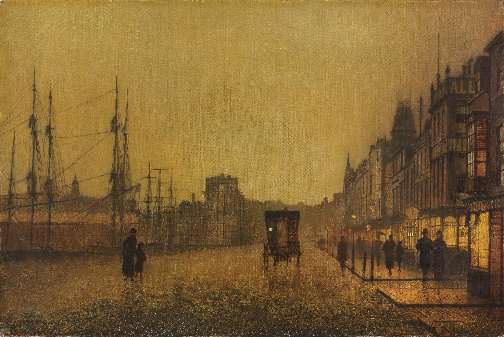 On Wednesday, September 27th, Bonhams’ location on New Bond Street in London hosted one of its 19th Century and British Impressionist sales, featuring one hundred nine lots by artists like Edward Seago, Archibald Thorburn, and Edward Lear, among many others. Bonhams’ specialists seem to have done rather well, predicting many of the top lots with some degree of accuracy. The top two lots were both by the British painter John Atkinson Grimshaw. Expected to sell for between £60K and £80K, Gourock Dock, Glasgow is a relatively small oil painting, measuring 12 by 18 inches. It shows a hazy street scene in Glasgow, Scotland’s largest city, where pedestrians and carriages travel down a main Street next to the docks on the River Clyde. It last sold at Christie’s London in 1992, going for £13K hammer, which would be about £27.3K / $33.1K today. It did significantly better this time, selling for slightly above estimate at £85K / $103.2K (or £108.4K / $131.6K w/p). The other painting, which immediately preceded it, is a more rural scene entitled A Moonlit Lane, Roundhay. Set just north of Leeds, the work is part of a series Grimshaw created in Roundhay in the early 1870s. Estimated to sell for between £50K and £70K, A Moonlit Lane sold exactly at its high estimate at £70K / $85K (or £89.3K / $108.5K w/p).
On Wednesday, September 27th, Bonhams’ location on New Bond Street in London hosted one of its 19th Century and British Impressionist sales, featuring one hundred nine lots by artists like Edward Seago, Archibald Thorburn, and Edward Lear, among many others. Bonhams’ specialists seem to have done rather well, predicting many of the top lots with some degree of accuracy. The top two lots were both by the British painter John Atkinson Grimshaw. Expected to sell for between £60K and £80K, Gourock Dock, Glasgow is a relatively small oil painting, measuring 12 by 18 inches. It shows a hazy street scene in Glasgow, Scotland’s largest city, where pedestrians and carriages travel down a main Street next to the docks on the River Clyde. It last sold at Christie’s London in 1992, going for £13K hammer, which would be about £27.3K / $33.1K today. It did significantly better this time, selling for slightly above estimate at £85K / $103.2K (or £108.4K / $131.6K w/p). The other painting, which immediately preceded it, is a more rural scene entitled A Moonlit Lane, Roundhay. Set just north of Leeds, the work is part of a series Grimshaw created in Roundhay in the early 1870s. Estimated to sell for between £50K and £70K, A Moonlit Lane sold exactly at its high estimate at £70K / $85K (or £89.3K / $108.5K w/p).
Third place ended up with a tie. The Birth of a Fairy by John Anster Fitzgerald is an incredibly fantastical work that looks less like a nineteenth-century watercolor and more like a scene from a Lewis Carroll work brought to life by the Hildebrandt Brothers. It is incredibly colorful and whimsical, with a broad ensemble of characters surrounding this small, white baby fairy emerging from a flower. Birds and insects, both anthropomorphized and naturally depicted, surround the entire scene. Fitzgerald was well-known during his lifetime for this kind of work, as fairies, other mythological beings, and the supernatural in general were of great interest to the general population of Victorian Britain. Meanwhile, there was also Return from the Hunt by John Frederick Herring Sr. An oil painting created in 1852, the Herring scene shows a pair of hunters with their dogs, likely in Scotland based on the landscape and the two men’s clothing. They have a pair of horses, upon which they have strapped some recently-shot deer. Bonhams house experts assigned the Fitzgerald an estimate range of £60K to £80K, while the Herring received a £40K to £60K estimate. Both fell within their ranges, hitting the lower end for the former at the high end for the latter at £60K / $72.9K (or £76.6K / $93K w/p).
Regarding surprises, there were only two of note. First was an interesting oil painting by the nineteenth-century Croatian artist Nikola Mašić. Created in Munich in 1879, Picking Pumpkins shows some peasant women removing pumpkins from their vines while a flock of turkeys comes in to inspect what’s going on. The painting was initially estimated to sell for no more than £7K. But with October right around the corner, I guess it’s not exactly surprising that some bidders that day drove the final price up to £19K / $23K (or £23.3K / $29.5K w/p), or around 2.7 times the high estimate. A little later on in the sale, there was a work by the English painter Henry Scott Tuke, mainly known for his male nudes. Though not a nude work, the painting Expectant shows a male youth sitting against a rock on the beach with his trouser legs rolled up. At the bottom right, Tuke’s spaniel Chippy is seen joining the boy. This work was most likely executed around 1921 on Newporth Beach, a little spot just south of the Cornish town of Falmouth, where Tuke had lived since he was a toddler. Records indicate the boy was likely a local teenager named Donald Rolph, who later modeled in several other Tuke paintings. Predicted by Bonhams specialists to sell for £20K at most, the beach portrait eventually sold for £55K / $66.80K (or £70.3K / $85.3K w/p), or 2.75 times the high estimate.
There was also another surprise, but this one wasn’t entirely positive. The expected star of the sale was a large oil painting by Sir Alfred James Munnings. The Old Gravel Pit, Swainsthorpe shows some horses grazing at the titular pit near a small town in Norfolk. The work is considered one of Munnings’s best from his early career, from around 1907, when the artist was about 29. Specialists identify the white horse in the foreground as Augereau, who appeared in many of Munnings’s works starting around this time. Soon after being first exhibited at the Royal Academy in 1908, a couple bought the piece for £150, or close to £15,000 in today’s money. The last time it sold at auction was at Sotheby’s London in 1995 for £185K hammer. Bonhams specialists gave the work an estimate range of £300K to £500K this time. However, when it finally came across the block, interest in the painting was unfortunately insufficient, and it went unsold. The sale’s underperformance cannot be blamed entirely on the Munnings, though, as it was one of thirty-three lots bought-in that day, giving the sale a 70% sell-through rate. Of the lots that sold, thirty-four sold within estimate, giving Bonhams specialists a 31% accuracy rate. Twenty-nine lots (27%) sold below estimate, while thirteen (12%) sold above. All one hundred nine lots brought in a total of £1,193,800 against a total pre-sale estimate range of £1.7 million and £2.6 million.
Phillips London Evening & Day Editions
 Starting on Thursday, September 21st, and continuing into the next day, Phillips London held a two-day modern and contemporary art extravaganza for their Evening and Day Editions. The two-part sale featured two hundred seventy-nine lots by twentieth- and twenty-first-century masters such as Banksy, Damien Hirst, Gerhard Richter, KAWS, and Takashi Murakami. The Evening Edition sale on September 21st featured the first seventy-two lots, including all four of the sale’s top lots. There was Andy Warhol’s 1985 portrait of Queen Elizabeth II from the Reigning Queens series, which took the top spot just two weeks after the anniversary of her passing. The Reigning Queens series originally consisted of four portraits each of four queens on the throne at the time of their creation, which in 1985 were Queen Elizabeth, Queen Beatrix of the Netherlands, Queen Margrethe II of Denmark, and Queen Ntfombi of Eswatini (formerly known as Swaziland). The portrait featured at Phillips on Thursday is from a special edition known as the Royal Edition, which the artist scattered with ground-up glass, or what Warhol referred to as diamond dust, that provides a sparkle to the screenprint (in 2012, the Royal Collection purchased a copy of all four color variations of the Queen Elizabeth Royal Edition prints). Estimated to sell between £120K and £180K, Queen Elizabeth eventually sold slightly above estimate for £205K / $252.1K (or £260.4K / $320.2K w/p).
Starting on Thursday, September 21st, and continuing into the next day, Phillips London held a two-day modern and contemporary art extravaganza for their Evening and Day Editions. The two-part sale featured two hundred seventy-nine lots by twentieth- and twenty-first-century masters such as Banksy, Damien Hirst, Gerhard Richter, KAWS, and Takashi Murakami. The Evening Edition sale on September 21st featured the first seventy-two lots, including all four of the sale’s top lots. There was Andy Warhol’s 1985 portrait of Queen Elizabeth II from the Reigning Queens series, which took the top spot just two weeks after the anniversary of her passing. The Reigning Queens series originally consisted of four portraits each of four queens on the throne at the time of their creation, which in 1985 were Queen Elizabeth, Queen Beatrix of the Netherlands, Queen Margrethe II of Denmark, and Queen Ntfombi of Eswatini (formerly known as Swaziland). The portrait featured at Phillips on Thursday is from a special edition known as the Royal Edition, which the artist scattered with ground-up glass, or what Warhol referred to as diamond dust, that provides a sparkle to the screenprint (in 2012, the Royal Collection purchased a copy of all four color variations of the Queen Elizabeth Royal Edition prints). Estimated to sell between £120K and £180K, Queen Elizabeth eventually sold slightly above estimate for £205K / $252.1K (or £260.4K / $320.2K w/p).
Just behind Her Majesty was one of several works offered by Roy Lichtenstein. This relief print, called Two Nudes, comes from one of the last series of works Lichtenstein executed before his death in 1997. The print shows two naked women depicted using the Ben-Day dots that often appear in Lichtenstein‘s work. The print reached its high estimate and sold at £200K / $245.9K (or £254K / $312.4K w/p). The third-place spot at Phillips came down to a tie. First was a collection of prints by Robert Indiana, all different-colored variations on his classic Love design. Completed in 1996, the series shows that Indiana wasn't entirely done with the iconic image even more than thirty years after first creating it. Each print measures around 18 by 18 inches and has an accompanying poem. While they can be displayed individually, to truly admire them, it might be best to have them kept as a proper book, where one can turn the pages and read the individual poem associated with its specific variation. There was also another Andy Warhol portrait, this one of the classical and romantic composer Ludwig van Beethoven. This screenprint is based on the famous portrait of the composer created by Joseph Karl Stieler around 1820 when Beethoven was 50 years old. Warhol applied an incredibly bright, vibrant color palette to the work, accentuating Beethoven’s hair and eyes with pink and purple. Meanwhile, what seems to be Beethoven’s hand-written copy of the Moonlight Sonata appears across the portrait as if the music is surrounding him. Phillips' specialists assigned the Indiana book a pre-sale estimate of £70K to £90K, while the Warhol portrait received a slightly lower estimate range of between £50K and £70K. Both achieved £80K / $98.4K (or £101.6K / $124.9K w/p).
While the Evening Edition featured all the top-selling works, the following Day Edition was far longer and contained all the surprises. In total, ten lots sold for double their high estimates or greater. These include a Joan Miró lithograph and a Tracey Emin etching. However, some of the day's biggest surprises included William Tillyer’s The Scalby Suite, a set of eight prints made through etching and aquatint. The eight prints were first created in 2022 and came accompanied by a certificate of authenticity. Estimated to sell for between £1500 and £2000, the Tillyer prints eventually sold for four times the high estimate at £8000 / $9.8K (or £10.2K / $12.4K w/p). Later, there is also Beautiful Exotic Stretching Etchy Spinning Void Etching, a drypoint print created by Damien Hirst in 1995. A small work measuring only 9 3/4“ x 7 7/8“, it was predicted by Phillips specialists to sell for no more than £1500, yet it sold for £9K / $11K (or £11.4K / $13.9K w/p), exactly six times the high estimate.
Overall, the Evening and Day Editions did incredibly well. With a total pre-sale estimate range of £1.9 million to £2.9 million, at the end of the day on Friday, the total fell nicely in-between at £2.2 million / $2.7 million. Of the two hundred seventy-nine available lots, one hundred eleven sold within their estimates, giving Phillips’ specialists a 40% accuracy rate. With sixty-seven lots (24%) selling under and fifty-eight lots (21%) selling over, only forty-three lots went unsold, giving the sale an 85% sell-through rate. The last time Phillips performed this well in a sale I covered was the June 8th Day Edition sale in London, which had a 93% sell-through rate.
Bob Ross’s First On-Air Painting For Sale

As far as great artists go, many throughout the last hundred years have been incredibly creative, technically innovative, and well-respected within the art world. However, most of them are nowhere near close to being household names than painter and art instructor Bob Ross. And now, the very first painting he created on his legendary PBS show will soon be up for sale.
Bob Ross hosted The Joy of Painting on PBS between 1983 and 1994. With a wily perm, a voice made from audible melatonin, and a technique allowing him to speed-paint thousands of landscapes, Bob Ross has remained part of the American cultural consciousness close to thirty years after his death. Many younger people became more familiar with Bob Ross and The Joy of Painting after the streaming service Twitch hosted a nine-day Joy of Painting marathon to commemorate Ross’s 73rd birthday. Around 5.6 million people watched, with part of the money from advertising going to charity.
The Kowalski family owns almost all of the paintings Ross created for The Joy of Painting. Annette and Walt Kowalski were Ross’s business partners and the subjects of a 2021 Netflix documentary about their alleged exploitation of Ross and his image. Their daughter Joan now runs Bob Ross Inc., which owns a warehouse in Virginia with almost all of the works created for Ross’s show. However, a few of the show’s paintings belong to other owners. For example, the Smithsonian acquired four of them in 2019. The first painting ever created for the show, A Walk in the Woods, is currently owned by the Modern Artifact gallery in Minneapolis. They acquired the work from a former PBS volunteer who had worked on the show and bought it during a fundraising auction. This is not the first Bob Ross painting Modern Artifact has owned, though. The gallery currently owns one other Ross work and has sold close to fifty others.
Modern Artifact is now offering the work for $9,850,000. Ryan Nelson, the owner of Modern Artifact, arrived at this hefty price tag not only because of its rarity but because of nostalgia and prominence on social media that has led to “an increased interest by the general public”. However, the gallery has also expressed its desire to exhibit the work and even take it on tour. Thus, the number becomes a good way to fend off any prospective buyers, allowing the gallery to do this.
Lost Old Master Confirmed: Guercino's Moses
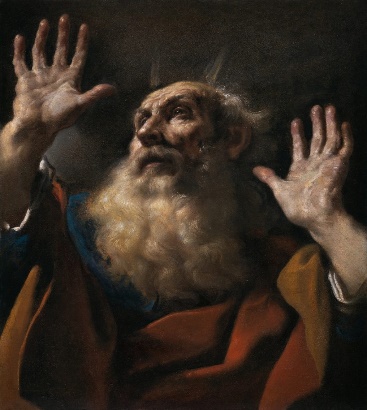 Last November, I wrote with some surprise that a lost Old Master painting may have been found at a Paris auction house. Those suspicions have more or less been confirmed. In November 2022, at the Paris auction house Chayette & Cheval, a seventeenth-century portrait of an old man thought to be by a student of the Bologna painter Guido Reni sold for €590K (or $610K). This was surprising since the house specialists expected it to sell for no more than €6K. Analysts predicted that whoever had purchased the work may have thought it was a lost masterpiece by the Italian baroque painter Guercino. The painting, a religious portrait entitled Moses, shares many attributes with several known Guercino works. These include Elijah Fed by Ravens at London’s National Gallery and Head of an Old Man at the Ashmolean Museum in Oxford. There are also copies of the work, most notably a version that appeared at auction in Venice in 2001 by Benedetto Zallone, one of Guercino’s students.
Last November, I wrote with some surprise that a lost Old Master painting may have been found at a Paris auction house. Those suspicions have more or less been confirmed. In November 2022, at the Paris auction house Chayette & Cheval, a seventeenth-century portrait of an old man thought to be by a student of the Bologna painter Guido Reni sold for €590K (or $610K). This was surprising since the house specialists expected it to sell for no more than €6K. Analysts predicted that whoever had purchased the work may have thought it was a lost masterpiece by the Italian baroque painter Guercino. The painting, a religious portrait entitled Moses, shares many attributes with several known Guercino works. These include Elijah Fed by Ravens at London’s National Gallery and Head of an Old Man at the Ashmolean Museum in Oxford. There are also copies of the work, most notably a version that appeared at auction in Venice in 2001 by Benedetto Zallone, one of Guercino’s students.
The buyer was Fabrizio Moretti, who operates Moretti Fine Art in London and Monte Carlo. After several months, the gallery has fully restored and researched the work. They have determined that it is from Guercino’s early artistic career, or his prima maniera. This period saw the painter working mainly in Cento, just outside of Bologna, creating altarpieces and accepting local commissions. This time ended in 1621 when the painter moved to Rome. The first time Moses entered the written record was in 1624, as part of the collection of Cardinal Alessandro d’Este. After the cardinal’s death, the d’Este family moved Moses to their collection in Modena before being shipped off to France during the Napoleonic era. After that, it becomes lost, only known through copies like Zallone's.
After restoration, Moretti found that the painting was in incredible condition. Valued at €6K barely a year ago, the portrait will be on display with a €2 million price tag (or $2.15 million) at the new Moretti Fine Arts location in Paris, which opened on Thursday, September 14th.
____________________
Deeper Thoughts
Another Divisive Raphael Attribution
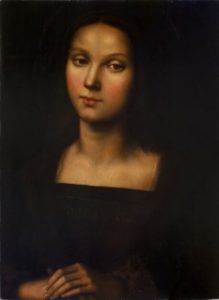 It seems like everyone’s claiming they have an original Raphael these days. With the ongoing debates over the De Brécy Tondo coming back into the news recently, another group of researchers claimed that a Mary Magdalene portrait currently in a private collection is likely an original by the Renaissance master. However, others are incredibly skeptical.
It seems like everyone’s claiming they have an original Raphael these days. With the ongoing debates over the De Brécy Tondo coming back into the news recently, another group of researchers claimed that a Mary Magdalene portrait currently in a private collection is likely an original by the Renaissance master. However, others are incredibly skeptical.
The Mary Magdalene portrait was dated around 1504 and is likely an oil-on-panel copy of another painting created by Pietro Perugino, of whom Raphael Sanzio was a student. The original picture by Perugino has been kept at the Palatine Galleries of the Pitti Palace in Florence since 1641. The figure is said to be based on Perugino’s wife, Chiara Fancelli, who modeled for her husband in several other works. Researchers presented their findings at a conference in Pergola, Italy, concluding that the Magdalene portrait in question is by Raphael after discovering various substances underneath the paint. They found a fine dust that they identified as pounce, also known as spolvero in Italian, which artists had used in transferring their designs. Irving Stone's biographical novel on Michelangelo, The Agony and the Ecstasy, described this process in great detail. In this process, an artist sketches their design on a piece of paper, then creates a series of small holes overtop the lines, making what is known as a cartoon. The artist then places the cartoon against a surface, whether a panel, a canvas, or a wall, and then dabs the holes with a pouch filled with ground charcoal or chalk, transferring the outline from the cartoon to the surface of their final work. The artist now has a rough design of their subject upon which to apply paint and other media. According to the researchers, Perugino did not use this method, but Raphael certainly did.
While some are hopeful about this news, others have their doubts. The most vocal skeptic has been the undersecretary of Italy’s Ministry of Culture, art critic Vittorio Sgarbi. I vaguely remembered his name from last May, when he commented on a portrait some were attributing to Titian: “If that’s a Titian, I’m Napoleon!” Sgarbi took to Twitter, again employing his sharp tongue: “Raphael? Impossible: at best, it’s a prototype by Pietro Perugino. It’s impossible that the painting announced in Pergola is by the master from Urbino.”
Furthermore, many have corrected the research team on one of their claims, pointing out that Perugino did, in fact, use spolvero in some of his works. Most notably, he used the technique in creating his frescoes at the Collegio del Cambio in Perugia. Other critics have also taken notice of the portrait’s alleged date. The original Perugino portrait was created around 1500, while the research team dates the supposed Raphael copy to 1504. Raphael experts claim that if this dating is correct, that means the copy is unlikely by Raphael. By 1504, Raphael was already an artist in his own right, not an apprentice anymore. Therefore, it would be confusing why he would create a copy of his teacher's work when he had already left Perugino’s workshop. The work must pre-date the Perugino portrait to be a genuine Raphael. This would be equally as confusing since why would the master go out of his way to copy the work of one of his pupils? A master may draw inspiration from their students’ work, but they rarely overtly copy. Some have also pointed out that one of the research team members, Annalisa di Maria, has been known to make inaccurate and rather premature attributions in the past.
More research must be done on the alleged Raphael to reach a more accurate conclusion on its authorship. The new research results will be published in an upcoming edition of the journal Art and Science, operated by Open Science.
Caravaggio: Master Of Darkness
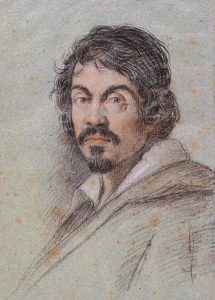 Earlier in the year, I wrote a piece on the British landscape painter J.M.W. Turner and his impact on modern art. Turner was known as a technical innovator, applying watercolor techniques to the medium of oil painting, achieving colors and textures that earned him the nickname 'The Painter of Light'. But if Turner is the Painter of Light, then it only makes sense for me to recognize the Master of Darkness: one of my favorite Old Master painters, Michelangelo da Caravaggio.
Earlier in the year, I wrote a piece on the British landscape painter J.M.W. Turner and his impact on modern art. Turner was known as a technical innovator, applying watercolor techniques to the medium of oil painting, achieving colors and textures that earned him the nickname 'The Painter of Light'. But if Turner is the Painter of Light, then it only makes sense for me to recognize the Master of Darkness: one of my favorite Old Master painters, Michelangelo da Caravaggio.
There are many artist archetypes, and many of them have a basis in reality. Michelangelo Buonarroti was the obsessive, while Leonardo was the procrastinator. Van Gogh and Pollock were both wily recluses, Raphael was the lover who died young, and Picasso was the cantankerous, abusive genius. Caravaggio, however, falls into a different category, one that very few people other than himself inhabit. He was the hot-headed bad-boy artist whose inner turmoil spilled onto his canvases. He was one of the major figures in the Catholic Counter-Reformation. To fight against new Protestant religious sects in Europe, the Catholic Church commissioned artists to create works that would reach out to common people and serve more or less as propaganda. Caravaggio did this by combining biblical stories with the aesthetic of daily life in sixteenth- and seventeenth-century Italy. While this was not uncommon during the Baroque period and previous eras, Caravaggio combined this artistic convention with a style with which his name has become inextricably linked: chiaroscuro.
Meaning light-dark, chiaroscuro is the intense contrast between light and dark in a work. In his paintings, many of his subjects almost seem to be emerging from complete darkness. This often made his works dramatic and intense in a way that had never been seen before. Only fifty years before Caravaggio’s birth (on September 29, 1571), the masters of the High Renaissance revived the classical ideal through their paintings and sculptures. Raphael and Michelangelo elevated the human form and the human experience. But by the time Michelangelo da Caravaggio came around, he was finding light and truth by delving down into the world's dark places.
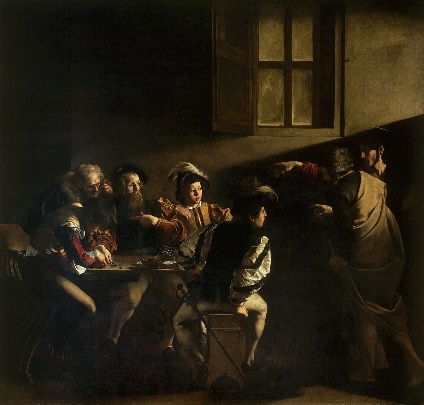 One of his most famous works, The Calling of Saint Matthew, shows the biblical story of Christ inspiring the tax collector Matthew to become one of his disciples. Many artists had previously put the scene to canvas, but never like this. Matthew sits with other tax collectors at a table, poring over their coins. He and his companions sit in what looks like a shadowy tavern, probably not unlike the ones scattered throughout Rome in the late 1500s, ones that the painting’s viewers would be intimately familiar with. Christ enters on the right, shrouded by darkness, raising his hand to point at the tax collector at the table. The line marking where the shadow ends and the light begins seems to follow the line of Jesus‘s finger, which leads directly to Matthew. This is the moment when Jesus asks Matthew to follow him, yet immediately before Matthew recognizes Christ and gets up from his table. Matthew sees Christ and points to himself as if to say, “Me?” Christ is shown as a light source in some religious paintings, yet here, he is in darkness but causes the illumination and enlightenment of others.
One of his most famous works, The Calling of Saint Matthew, shows the biblical story of Christ inspiring the tax collector Matthew to become one of his disciples. Many artists had previously put the scene to canvas, but never like this. Matthew sits with other tax collectors at a table, poring over their coins. He and his companions sit in what looks like a shadowy tavern, probably not unlike the ones scattered throughout Rome in the late 1500s, ones that the painting’s viewers would be intimately familiar with. Christ enters on the right, shrouded by darkness, raising his hand to point at the tax collector at the table. The line marking where the shadow ends and the light begins seems to follow the line of Jesus‘s finger, which leads directly to Matthew. This is the moment when Jesus asks Matthew to follow him, yet immediately before Matthew recognizes Christ and gets up from his table. Matthew sees Christ and points to himself as if to say, “Me?” Christ is shown as a light source in some religious paintings, yet here, he is in darkness but causes the illumination and enlightenment of others.
Caravaggio was a man of the streets. He spent his time in taverns drinking, mingling with prostitutes, dueling those who insulted him with his sword. It’s unsurprising that he often used the people on the streets as his models. His Death of the Virgin is probably the epitome of this practice. Normally, during the Renaissance, artists stopped showing the Virgin Mary’s death and preferred to show her assumption, her rising and being welcomed into heaven. Such subjects had been executed by El Greco, Correggio, Fra Bartolomeo, Dürer, and Titian, among others. However, Caravaggio decided to revive the earlier convention of not showing her elevated and in glory, but rather as a mortal person. He depicts the Virgin lying across a bed in a red dress. A group of figures gathers about, some mourning while others talk among themselves. The men are somewhat obscured, while the unseen light source in the upper left mostly illuminates Mary’s body. Her skin is pale, and her limbs are limp and lifeless. She is no longer the Virgin Mary; she is just a woman who has recently died. Stories say that Caravaggio used the body of a dead prostitute fished out of the River Tiber as his model.
His vices and his faith collided on the canvas. Towards the end of his life, this became ever more apparent as he was on the run after killing a man in a duel. As an interesting form of penance, Caravaggio created one of his most interesting works, at least in my opinion, that of David with the Head of Goliath. He actually made two versions of this painting, but the one now housed in the Galleria Borghese in Rome is far more interesting. It is thought to be a double self-portrait, with the likeness of his younger self holding up the decapitated head of his debauched, sinful, older self. It’s a poignant mea culpa transferred to the canvas.
Unfortunately, Caravaggio died in 1610 at the age of 38 from what is thought to have been lead poisoning. He collapsed alone on a beach in Tuscany, still on the run with a price on his head. Many great artists, like Raphael, Van Gogh, and Basquiat, died before they perhaps should have. And like with them, we will never know how much more Michelangelo da Caravaggio would have contributed. We do not know to what extent art today would be different had his own personal darkness that made him brilliant and infamous not cut his life short.
Arc de Triomphe, Recycled
Around two years ago, the final work by the environmental artist Christo Javacheff was completed in Paris when a team completely wrapped the Arc de Triomphe in blue-silver fabric. The project had been several decades in the making, ever since Christo and his wife and artistic partner Jeanne-Claude Denat de Guillebon first imagined the idea in 1961. Wrapping the famous Paris monument took almost 270,000 square feet of fabric and more than 9,800 feet of rope, all made from recyclable polypropylene. Now, some organizations are taking advantage of the posthumous project's materials, as the fabric and ropes will all be reused for the upcoming 2024 Paris Olympics.
 The Mayor of Paris, Anne Hidalgo, announced that the organization Parley for the Oceans would help convert the materials used for Arc de Triomphe, Wrapped into “shade structures, tents or barnums”. Parley for the Oceans is familiar with this work, having previously collaborated with Adidas and Dior to help craft new sustainability policies. Furthermore, this is far from the first time someone reused the materials from a former Christo and Jeanne-Claude installation. The Floating Piers was an installation of a floating dock system lined with saffron-colored fabric on northern Italy’s Lake Iseo. After disassembly, all 750,000 square feet of fabric were recycled into crafts materials for consumer use. Hidalgo described this quality as exemplary of “ the art world’s ability to adapt to climate challenges”. The wood and steel structures that protected the Arc de Triomphe during the installation have already been recycled, being put to good use by the carpenters and steel workers they were given to.
The Mayor of Paris, Anne Hidalgo, announced that the organization Parley for the Oceans would help convert the materials used for Arc de Triomphe, Wrapped into “shade structures, tents or barnums”. Parley for the Oceans is familiar with this work, having previously collaborated with Adidas and Dior to help craft new sustainability policies. Furthermore, this is far from the first time someone reused the materials from a former Christo and Jeanne-Claude installation. The Floating Piers was an installation of a floating dock system lined with saffron-colored fabric on northern Italy’s Lake Iseo. After disassembly, all 750,000 square feet of fabric were recycled into crafts materials for consumer use. Hidalgo described this quality as exemplary of “ the art world’s ability to adapt to climate challenges”. The wood and steel structures that protected the Arc de Triomphe during the installation have already been recycled, being put to good use by the carpenters and steel workers they were given to.
Arc de Triomphe, Wrapped was the first Christo and Jeanne-Claude work executed after both of their deaths. Jeanne-Claude passed away in 2007, while Christo died in 2020. However, many of their ideas can still be carried out. For example, Christo and Jeanne-Claude’s 1977 plans for an installation called The Mastaba will be carried out in the United Arab Emirates within the next few years. It will likely be a larger version of London Mastaba, an installation Christo erected in London’s Hyde Park in 2016. The Mastaba will be situated in the desert about 100 miles south of Abu Dhabi. If completed, it will be the largest sculpture by volume in the world and will be Christo and Jeanne-Claude’s only permanent installation.
Art History Myths: Broken Down
Myths, stories, and apocrypha have always surrounded art and artists. Some start with a grain of truth, while others are just made up entirely. Here is just a short collection of some of my favorites…
What is The Scream?
 Edvard Munch’s The Scream is one of the world’s most iconic modern paintings. It shows a person with an anguished look gripping their face in the middle of a pathway. While one might assume that the work’s title refers to the subject’s action, interestingly enough it does not. The title does not refer to the screaming subject but the subject hearing a scream. Some have posited that they are hearing screams from a nearby asylum, but it is far more mystical than that. Munch originally exhibited The Scream under the German title Der Schrei der Natur, or The Scream of Nature. Munch originally conceived the idea while walking across a path over a fjord near Oslo. In January 1892, Munch wrote, “I stopped and looked out over the fjord – the sun was setting, and the clouds turning blood red. I sensed a scream passing through nature; it seemed to me that I heard the scream.” He had likely suffered a panic attack at this moment. Munch makes the red sky appear as thought it is vibrating like an actual scream reverberating through nature. However, the other figures further along the path seem undisturbed, as if the scream is only in the subject’s head.
Edvard Munch’s The Scream is one of the world’s most iconic modern paintings. It shows a person with an anguished look gripping their face in the middle of a pathway. While one might assume that the work’s title refers to the subject’s action, interestingly enough it does not. The title does not refer to the screaming subject but the subject hearing a scream. Some have posited that they are hearing screams from a nearby asylum, but it is far more mystical than that. Munch originally exhibited The Scream under the German title Der Schrei der Natur, or The Scream of Nature. Munch originally conceived the idea while walking across a path over a fjord near Oslo. In January 1892, Munch wrote, “I stopped and looked out over the fjord – the sun was setting, and the clouds turning blood red. I sensed a scream passing through nature; it seemed to me that I heard the scream.” He had likely suffered a panic attack at this moment. Munch makes the red sky appear as thought it is vibrating like an actual scream reverberating through nature. However, the other figures further along the path seem undisturbed, as if the scream is only in the subject’s head.
Van Gogh, the Unrecognized Genius
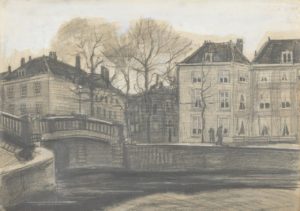 One of the most common factoids about Vincent van Gogh is how he was not fully recognized outside of artistic circles in his lifetime. One myth that gets a lot of attention is that he only sold one painting in his lifetime when Anna Boch bought The Red Vineyard at Arles. However, this was far from the only painting Van Gogh sold. He received commissions rather early in his career, most notably from his uncle Cornelis van Gogh, who commissioned him to create a series of cityscapes of The Hague in 1882. Though he went unrecognized for a good portion of his career, Van Gogh did start to gain some visibility towards the end of his life. Around 1887, three years before his suicide, patrons began hanging his work at their cafés and shops. Plus, he not only sold his own paintings, but he sold those of others as well. The Van Gogh family was a family of art dealers in the Netherlands for generations. Vincent’s uncle, also named Vincent but called Uncle Cent, was a partner at Goupil & Cie, one of continental Europe's most prestigious art dealers. Cent even ran their location in The Hague for a time, where, starting in 1869, he employed his nephew Vincent, aged 16. Vincent worked at the Hague and London locations, doing very well at the former but less so at the latter.
One of the most common factoids about Vincent van Gogh is how he was not fully recognized outside of artistic circles in his lifetime. One myth that gets a lot of attention is that he only sold one painting in his lifetime when Anna Boch bought The Red Vineyard at Arles. However, this was far from the only painting Van Gogh sold. He received commissions rather early in his career, most notably from his uncle Cornelis van Gogh, who commissioned him to create a series of cityscapes of The Hague in 1882. Though he went unrecognized for a good portion of his career, Van Gogh did start to gain some visibility towards the end of his life. Around 1887, three years before his suicide, patrons began hanging his work at their cafés and shops. Plus, he not only sold his own paintings, but he sold those of others as well. The Van Gogh family was a family of art dealers in the Netherlands for generations. Vincent’s uncle, also named Vincent but called Uncle Cent, was a partner at Goupil & Cie, one of continental Europe's most prestigious art dealers. Cent even ran their location in The Hague for a time, where, starting in 1869, he employed his nephew Vincent, aged 16. Vincent worked at the Hague and London locations, doing very well at the former but less so at the latter.
Michelangelo On His Back
 Irving Stone’s biographical novel The Agony and the Ecstasy, about the life of Michelangelo Buonarroti, is one of the greatest books about art I have ever read. But if you don’t have the time for that, the 1965 film adaptation with Charleton Heston as Michelangelo, containing a small fraction of the book’s contents, is a beautiful movie. One of the most iconic images, shown in both the book and the film, is Michelangelo lying on his back on the scaffolding he’s constructed, paint dripping onto his face as he paints the ceiling of the Sistine Chapel. While it is a striking image, this is unfortunately another myth. This misconception comes from one of his contemporaries, Paolo Giovio, who wrote that this must have been how Michelangelo created the monumental work. However, writers, chroniclers, biographers, and other contemporaries agree that Michelangelo and his assistants stood up to paint. They stood on the scaffolding, crooking their necks the entire time, causing neck and back pain that Michelangelo wrote about later in life, providing a crude drawing of himself painting on the ceiling while standing.
Irving Stone’s biographical novel The Agony and the Ecstasy, about the life of Michelangelo Buonarroti, is one of the greatest books about art I have ever read. But if you don’t have the time for that, the 1965 film adaptation with Charleton Heston as Michelangelo, containing a small fraction of the book’s contents, is a beautiful movie. One of the most iconic images, shown in both the book and the film, is Michelangelo lying on his back on the scaffolding he’s constructed, paint dripping onto his face as he paints the ceiling of the Sistine Chapel. While it is a striking image, this is unfortunately another myth. This misconception comes from one of his contemporaries, Paolo Giovio, who wrote that this must have been how Michelangelo created the monumental work. However, writers, chroniclers, biographers, and other contemporaries agree that Michelangelo and his assistants stood up to paint. They stood on the scaffolding, crooking their necks the entire time, causing neck and back pain that Michelangelo wrote about later in life, providing a crude drawing of himself painting on the ceiling while standing.
Jackson Pollock’s Work Playlist
 Jackson Pollock’s paintings are some of the textbook definitions of ‘modern art’. His splatter technique, which he called “action painting”, was innovative through its free-flowing, almost improvisational style. It was similar to another art form, one that Pollock himself enjoyed very much: jazz. His love of classic New Orleans jazz, swing, and the songs of Billie Holiday are well-noted by his friends and contemporaries. In 1999, the Museum of Modern Art released a compilation CD called Jackson Pollock: Jazz, featuring Jelly Roll Morton, Artie Shaw, Fats Waller, and others from Pollock’s collection. This has given rise to the story that Jackson Pollock painted while listening to jazz. While it’s a powerful image, it is unfortunately untrue. Pollock’s primary studio was a barn next to his home on Long Island. It had no power source, so listening to the radio or jazz records would have been difficult.
Jackson Pollock’s paintings are some of the textbook definitions of ‘modern art’. His splatter technique, which he called “action painting”, was innovative through its free-flowing, almost improvisational style. It was similar to another art form, one that Pollock himself enjoyed very much: jazz. His love of classic New Orleans jazz, swing, and the songs of Billie Holiday are well-noted by his friends and contemporaries. In 1999, the Museum of Modern Art released a compilation CD called Jackson Pollock: Jazz, featuring Jelly Roll Morton, Artie Shaw, Fats Waller, and others from Pollock’s collection. This has given rise to the story that Jackson Pollock painted while listening to jazz. While it’s a powerful image, it is unfortunately untrue. Pollock’s primary studio was a barn next to his home on Long Island. It had no power source, so listening to the radio or jazz records would have been difficult.
Raphael Attribution Causes AI Battle
 Some months ago, I wrote about how a pair of British scientists used a facial recognition AI program to positively attribute a Madonna and Child painting to the Italian Renaissance master Raphael Sanzio. While this gained an incredible amount of attention in the press, very few people seemed to understand how misleading and flawed this claim was. And now, more people have added to the debate over the authorship of this painting.
Some months ago, I wrote about how a pair of British scientists used a facial recognition AI program to positively attribute a Madonna and Child painting to the Italian Renaissance master Raphael Sanzio. While this gained an incredible amount of attention in the press, very few people seemed to understand how misleading and flawed this claim was. And now, more people have added to the debate over the authorship of this painting.
The Madonna and Child painting, also known as the De Brécy Tondo, is considered by most art historians to be a later copy of a verified Raphael painting known as the Sistine Madonna, now kept at the Gamäldegalerie Alte Meister in Dresden, Germany. The only legitimate debate regarding the painting is when exactly it was created. Some claim it’s a nineteenth-century Victorian reproduction, while some chemical tests indicate it may have been made as early as the sixteenth century. For decades, the work’s previous owners, including the current one, Timothy Benoy, have pushed for its recognition as a legitimate Raphael. The facial recognition analysis done by Dr. Christopher Brooke and Dr. Hassan Ugail from the University of Nottingham and the University of Bradford, respectively, undoubtedly added some legitimacy to these claims among the general public. Then, there was the painting’s exhibition at Cartwright Hall Art Gallery in Bradford, where people could see this alleged Raphael up close.
However, facial recognition analysis only verified that the Madonna in the De Brécy Tondo and the Madonna in the Sistine Madonna were 97% similar. This does not mean that the same artist created the two paintings. That is simply an extrapolation that requires several leaps in logic to make. The fact that the faces are almost identical does not mean the same hand created them, nor does it debunk the claim that the Tondo is a later copy. Besides, it wouldn’t be much of a copy if it didn’t try to look exactly like the original. But now, even other AI experts are weighing in on the skeptics' side. Carina Popovici is part of the Swiss AI company Art Recognition and has been involved in other cases of AI art attribution. Most notably, in one case I’ve written about, Art Recognition analyzed the Samson & Delilah painting by Peter Paul Rubens kept at the National Gallery in London. Art Recognition’s AI software is very different from just facial recognition. It uses a convolutional neural network, dividing the canvas into a grid and analyzing each cell for brushstroke patterns and color. The program compared this data to a control group of verified Rubens paintings and concluded that the National Gallery Samson & Delilah is likely not a genuine Reubens painting. Using her software, Popovici found that there is an 85% chance that the De Brécy Tondo is not, in fact, by Raphael.
This latest development only shows that, like in any academic field, one study does not make a consensus. Art historians and conservators agree that the De Brécy Tondo is not by Raphael Sanzio but rather a copy of his Sistine Madonna. A single AI program’s results will not drastically change anything, especially if a different AI program can easily contradict them. Popovici’s studies show the need for repeated, replicable results to confirm a hypothesis, part of the scientific method governing the physical and social sciences. Artificial intelligence can be a powerful tool in uncovering new information about paintings and other artworks. However, it is often the most effective if used in tandem with studies by experts in the field.
New Dalí Museum
 Salvador Dalí already has a museum dedicated to him. The Dalí Theater and Museum is located in the Catalonian town of Figueres, his hometown about 70 miles northeast of Barcelona, close to the border with France. It was originally the town’s municipal theater, which the artist transformed into a museum for his work in the 1960s. Not only did the famous Spanish surrealist live in a part of the building during his final years, but he was also buried there. And now, the town will get another Dalí museum in his old family home just 400 meters down the street.
Salvador Dalí already has a museum dedicated to him. The Dalí Theater and Museum is located in the Catalonian town of Figueres, his hometown about 70 miles northeast of Barcelona, close to the border with France. It was originally the town’s municipal theater, which the artist transformed into a museum for his work in the 1960s. Not only did the famous Spanish surrealist live in a part of the building during his final years, but he was also buried there. And now, the town will get another Dalí museum in his old family home just 400 meters down the street.
After four years of renovations and preparations, the Salvador Dalí Birthplace (Casa Natal de Salvador Dalí) will finally open its doors. Turning the artist’s childhood home into a museum has been a project nearly thirty years in the making. The town council of Figueres originally bought the ground floor of the building in 1996. This was where Dalí's father had his office as a notary. A few years later, the council also purchased the building’s mezzanine, where the family apartment was. Over the years, it has refurbished the space, both inside and out, adding up to about €1.9 million. The town council, the regional council of Girona, the Generalitat de Catalunya, and the European Union have all had a hand in helping the project along.
The museum was originally set to open in July, but delays set back the opening date. “There is no other site in the world that explains the person and the character of Dalí, hence the necessity to explain where it all began,” said Eduard Bech, director of the Empordà Museum, also in Figueres. The museum will almost be a foil to the Dalí Theater and Museum, as the birthplace museum will be a far more intimate look at the artist. The museum will explore daily life in the town in the early twentieth century and the artist’s relationships with his family members. For example, Dalí had a difficult relationship with his father, who threw him out of the house and disinherited him at 25 in 1929. Of course, it wasn’t that exact house. When Dalí was seven years old, the family moved to a building closer to Palmera Plaza. Visitors can also view faded drawings on the walls of Dalí’s old bedroom. Though we don’t know for sure who created them, I think most people have a pretty good idea.
The Salvador Dalí Birthplace will open in Figueres on October 20th.
The Rehs Family
© Rehs Galleries, Inc., New York – October 2023
